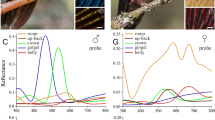7. Summary
Observations are described with the feathers ofCoracias Indica which throw doubt on the correctness of the theory that the blue of these feathers is a simple Tyndall effect due to the scattering of light by minute air cavities within the substance of the barb. Observations with the “Ultra-opak” microscope show that the coloured layers may exhibit tints ranging over the whole spectrum. A simple Tyndall effect is thus definitely insufficient to explain the observed phenomena. Further studies indicate that the cavities responsible for the colours are extended structures. The two alternative possibilities, namely, diffraction by cavities not small compared with the wave-length and interferences from the surfaces of minute films are considered and discussed, without a final decision being reached.
Similar content being viewed by others
Reference
C. W. Mason,J. Phys. Chem.,27, 201, 1923.
Author information
Authors and Affiliations
Rights and permissions
About this article
Cite this article
Raman, C.V. The origin of the colours in the plumage of birds. Proc. Indian Acad. Sci. (Math. Sci.) 1, 1–7 (1934). https://doi.org/10.1007/BF03035682
Received:
Issue Date:
DOI: https://doi.org/10.1007/BF03035682




